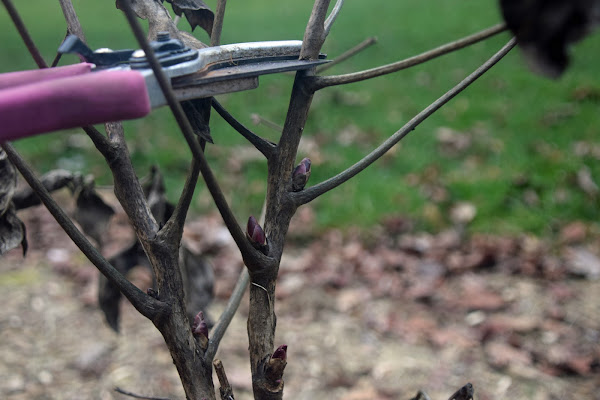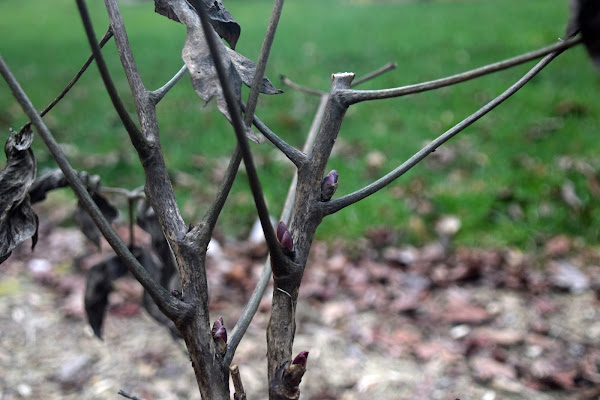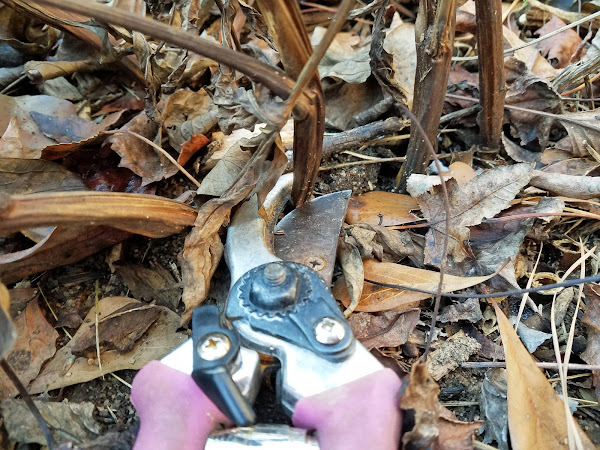
Tree Peony with Dead Foliage
After a while that beautiful tree peony goes from gorgeous to gross, and you just want to erase it from your landscape. In order to get it looking decent again (and ready for spring), you need to cut it back. Cutting it back also removes parts of the stem that won't be needed next season and all of the dead foliage, which could harbor disease. The parts of the stem you will want to remove are any bloom stems that either bloomed or failed to bloom, but you don't want to cut off too much, as you don't want to lose any growth buds, which is where the peony will start to grow from in the spring.

Cut Tree Peony Bloom Stem 1" Above Top Bud
There are different ways you can cut back your peony stems and different methods of removing the foliage. I'll go over both of them here. The first way of cutting back the bloom stems is to cut the bloom stem back to 1 inch above the top growth bud on the stem. Using your pruners cut the stem at an angle (to prevent water pooling/damage) 1 inch above the leaf joint that contains a rounded, sometimes pinkish growth tip.

Tree Peony After Bloom Stem Cut 1" Above Top Bud

Tree Peony Bloom Stem Cut Back
After the bloom stem has been cut off, next the foliage stems should also be pruned. The foliage stems can be cut back to about 2 inches to leave a pointy, pokey hardened foliage stem to protect the growth bud, while the dead leaves will be removed and thrown away. These hard stems can be useful if you have a problem with animals that like to browse your tree peonies (like deer). It is not a huge obstacle, but an obstacle nonetheless, and may help protect your peonies from hungry animals.

Cut Tree Peony Leaf Stems Down to 2"
After one foliage stem has been cut back, continue cutting back all of the foliage stems on that main stem to 2 inches as well. As you are cutting the foliage, make sure you are placing it in a bucket or bag for disposal. Don't leave the dead stems and foliage on the ground underneath the tree peony. This will help with plant hygiene and health.

Cut Tree Peony Leaf Stems Down to 2"

Dispose of Tree Peony Stems & Foliage

Cut Tree Peony Bloom Stem Just Above 1 Segment Higher than Top Bud
Another way to cut back the peony bloom stem is to make your cut a little higher on the tree peony stem, one leaf segment above the top bud. This may be a useful method if you are concerned about severe cold or dieback in your peony stems. Here in my garden in the South, we don't usually have to worry about temperatures that cold. Some Northern states keep snow cover all winter to protect the peonies. However if you live in an area with extreme cold and no snow cover, you may be a bit more concerned about stem dieback. Or perhaps you've experienced stem dieback in the past, in which case this maybe the method that you choose.

Tree Peony After Bloom Stem Cut
Just Above 1 Segment Higher than Top Bud

Remove Foliage Stems
from Tree Peony |

Pull Down Tree Peony Foliage Stem to Pop Stem Off
|
Another method of removing tree peony foliage stems is pretty easy and doesn't require any clippers. You simply pop them off by pressing the foliage stem in the opposite direction than it was growing. The entire foliage stem removes cleanly. I like to use this method for any foliage segments that do not have a growth bud in them. Since there is no growth bud that needs protection, the entire foliage stem can be removed, leaving the tree peony a bit more clean.

Tree Peony After Foliage Stem Popped Off
You can then continue cutting back any foliage stems with growth buds at the base. Keep repeating these processes until you have cut back all bloom stems and removed or cut back all foliage stems as well. After you are finished with the entire tree peony plant, it will be back to stems only, be so much cleaner, and ready for spring!! Happy Garden Cleaning!!!

Cut Back Foliage Stems to 2" to Protect Growth Buds

Tree Peony Cleaned Up & Ready for Spring!






















